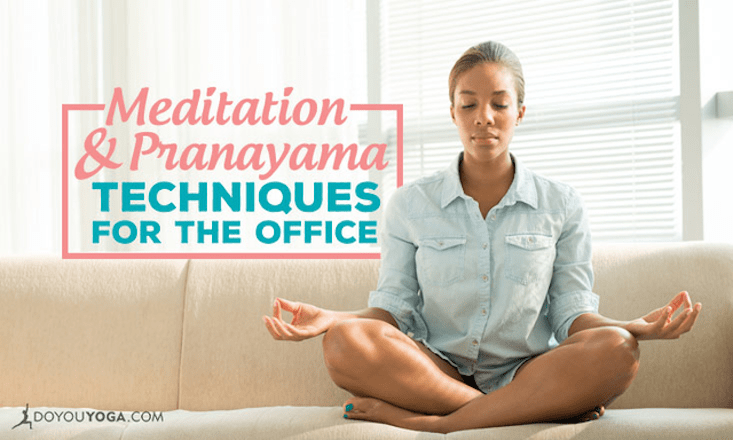If you find yourself feeling stressed and anxious at the office, or feeling like any small additional task will make your bucket overflow, it’s time to take a break.
Much like in yoga, less is more when it comes to stress management, which means it is more effective to take shorter exercises regularly rather than one long holiday per year. Small breaks ensure that your stress levels will not take the best of you.
Below are five easy meditation and pranayama techniques to help you relax and bring some peace and calm into your office days!
1. Bring the attention to your body .
The body is always in the present moment, so when we focus on it, the mind will quiet. Start by sitting comfortably and closing your eyes.
Relax your shoulders, and place your hands on your lap. Take a few deep breaths, and allow your body to relax with each exhale. Start rotating your awareness within your body starting with your toes, and begin to imagine a wave of relaxation moving slowly up your legs all the way to the hips.
Then, bring your awareness to your fingers, and imagine a wave of relaxation moving up through your hands all the way to your shoulders. Allow your belly to relax, and feel your breath moving your chest and stomach. Relax your back muscles, your neck muscles, and your head.
Finally, let go of any tension in your facial muscles and jaw. Observe your body, and move the wave of relaxation where it’s mostly needed.
Continue for 5 to 10 minutes before resuming your tasks.
2. Extend the exhale .
Stuck in a boring meeting? Start following your breath and invite your body to unwind. Take your attention to your breath, and first just observe how it feels. Is it long and steady, or short and shallow? Start to take longer breaths, fully inhaling, and fully exhaling.
Then, count to 4 as you inhale, and count to 6 as you exhale, making your exhale slightly longer than your inhale. After a time, this will calm the body by promoting the parasympathetic nervous system, which is responsible for slowing the heart rate and allowing the body to rest.
Keep counting your inhale and exhale for 5 to 10 minutes before resuming normal breath again.
3. Try triangle breathing .
Triangle breathing will calm your mind and balance your body. If you find yourself in a heated moment, you can focus on this technique no matter where you are.
To start, inhale and exhale once fully. On the next breath, count the length of your inhale. Then, as you continue to breathe, use that same count duration to inhale, hold, and exhale. For example, if your count is 4, you will inhale for 4 counts, hold for 4 counts, and exhale for 4 counts.
Draw this triangle with your breath for few rounds. If you feel comfortable, slowly increase the size of your triangle with one count at a time. If you feel yourself getting out of breath, return to the previous count.
Concentrate on this triangle breathing for at least 3 to 5 minutes, and even longer if you feel comfortable. Return to your normal breath for few rounds before finishing the exercise.
4. Change the feeling of stress.
The next time you feel stressed or uncomfortable because you are too busy, stop and try to identify where in your body this stress is located.
Do you feel it in your head, throat, chest, or belly? Close your eyes, and fully bring your awareness to this feeling. Does it have a movement, a distinct shape, a color? Does it feel hot or cold? Does it have a smell?
Then, try to change these variables one by one. Try to change the shape into something nicer. Try to change the color, movement, or even location of the feeling. Once you identify the feeling as a separate entity within you, you can play with it more freely. This practice of control over how you feel stress will be beneficial.
5. Alternate nostril breathing.
Alternate nostril breathing can boost your thinking, release stress, and harmonize the right and left hemispheres of the brain.
To begin, sit comfortably, and close your eyes. Place your right hand close to your face, so that you can block the right nostril with your right thumb and the left nostril with your ring finger. Your index finger and middle finger can rest on your forehead.
First, close off the right nostril, and slowly inhale through the left nostril. Pause, close the left nostril, and breathe out through the right nostril. Inhale again through the right nostril, pause, close the right nostril with your thumb, and breathe slowly out through the left nostril.
Continue for 2 to 5 minutes and return to normal breath for few rounds before resuming your tasks.
Now try these techniques out whenever you start to feel stress build up, and notice how much more relaxed and refreshed you feel.


